AWM41 1056 - [Nurses Narratives] Mrs McHardie White - Part 2
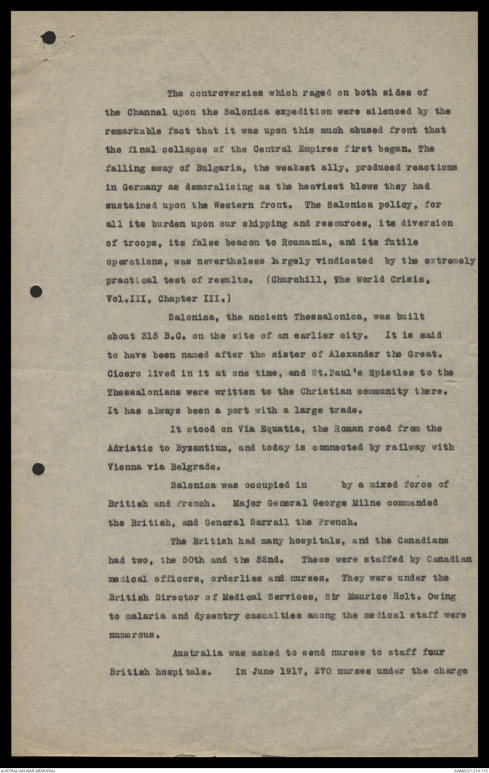
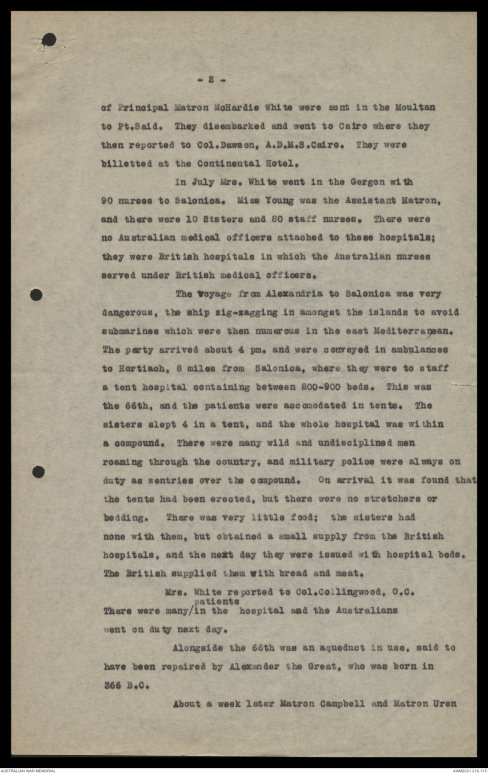
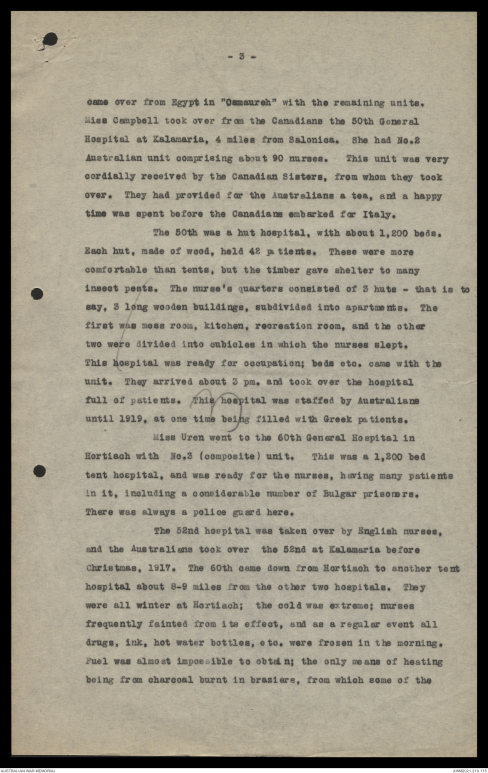
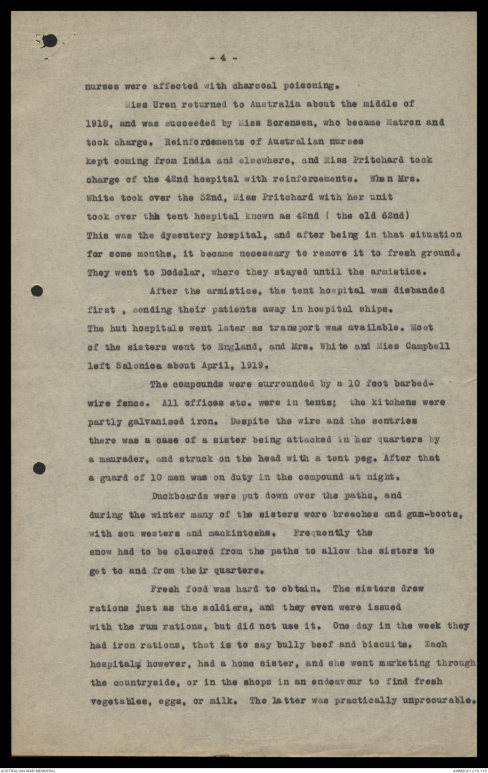
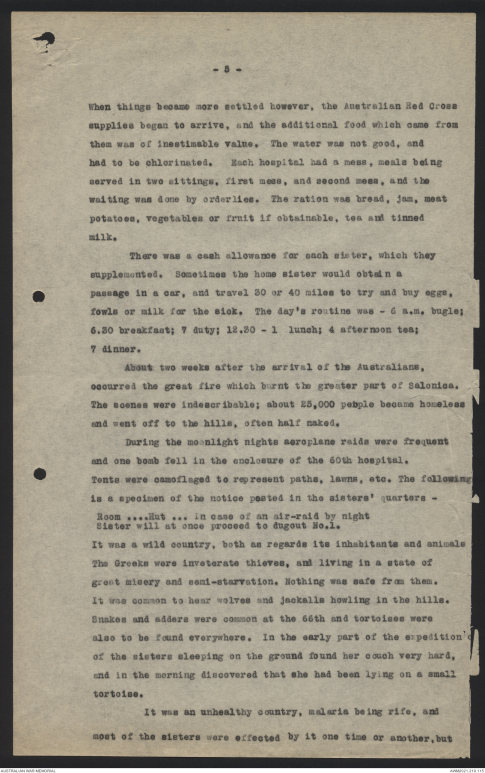
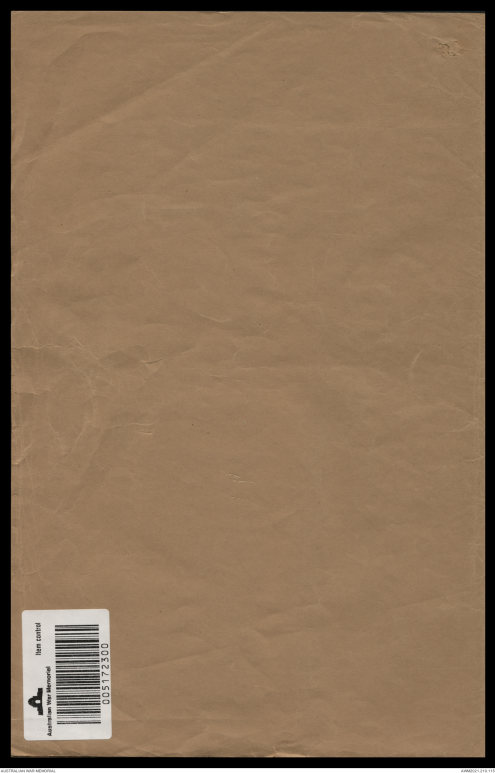
The controversies which raged on both sides of
the Channel upon the Salonica expedition were silenced by the
remarkable feat that it was upon this much abused front that
the final collapse of the Central Empires first began. The
falling away of Bulgaria, the weakest ally, produced reactions
in Germany as demoralising as the heaviest blows they had
sustained upon the Western front. The Salonica policy, for
all its burden upon our shipping and resources, its diversion
of troops, its false beacon to Roumania, and its futile
operations, was nevertheless largely vindicated by the extremely
practical test of results. (Churchill, The World Crisis,
Vol.III, Chapter III.)
Salonica, the ancient Thessalonica, was built
about 315 B.C. on the site of an earlier city. It is said
to have been named after the sister of Alexander the Great.
Cicero lived in it at one time, and St.Paul's Epistles to the
Thessalonians were written to the Christian community there.
It has always been a port with a large trade.
It stood on Via Equatia, the Roman road fromthe
Adriatic to Bysantium, and today is connected by railway with
Vienna via Belgrade.
Salonica was occupied in by a mixed force of
British and French. Major General George Milne commanded
the British, and General Sarrail the French.
The British had man hospitals, and the Canadians
had two, the 50th and the 52nd. These were staffed by Canadian
medical officers, orderlies and nurses. They were under the
British Director of Medical Services, Sir Maurice Holt. Owing
to malaria and dysentry casualties among the medical staff were
numerous.
Australia was asked to send nurses to staff four
British hospitals. In June 1917, 270 nurses under the charge
-2-
of Principal Matron McHardie White were sent in the Moultan
to Pt.Said. They disembarked and went to Cairo where they
then reported to Col.Dawson, A.D.M.S.Cairo. They were
billetted at the Continental Hotel.
In July Mrs. White went in the Gergon with
90 nurses to Salonica. Miss Young was the Assistant Matron,
and there were 10 Sisters and 80 staff nurses. There were
no Australian medical officers attached to these hospitals;
they were British hospitals in which the Australian nurses
served under British medical officers.
The voyage from Alexandria to Salonica was very
dangerous, the ship zig-zagging in amongst the islands to avoid
submarines which were then numerous in the east Mediterranean.
The party arrived about 4 pm. and were conveyed in ambulances
to Hortiach, 8 miles from Salonica, where they were to staff
a tent hospital containing between 800-900 beds. This was
the 66th, and the patients were accomodated in tents. The
sisters slept 4 in a tent, and the whole hospital was within
a compound. There were many wild and undisciplined men
roaming through the country, and military police were always on
duty as sentries over the compound. On arrival it was found that
the tents had been erected, but there were no stretchers or
bedding. There was very little food; the sisters had
none with them, but obtained a small supply from the British
hospitals, and the next day they were issued with hospital beds.
The British supplied them with bread and meat.
Mrs. White reported to Col. Collingwood, O.C.
There were many ∧patients in the hospital and the Australians
went on duty next day.
Alongside the 66th was an aqueduct in use, said to
have been repaired by Alexander the Great, who was born in
366 B.C.
About a week later Matron Campbell and Matron Uren
-3-
came over from Egypt in "Osmaureh" with the remaining units.
Miss Campbell took over from the Canadians the 50th General
Hospital at Kalamaria, 4 miles from Salonica. She had No.2
Australian unit comprising about 90 nurses. This unit was very
cordially received by the Canadian Sisters, from whom they took
over. They had provided for the Australians a tea, and a happy
time was spent before the Canandians embarked for Italy.
The 50th was a hut hospital, with about 1,200 beds.
Each hut, made of wood, held 42 patients. These were more
comfortable than tents, but the timber gave shelter to many
insect pests. The nurse's quarters consisted of 3 huts - that is to
say, 3 long wooden buildings, subdivided into apartments. The
first was mess room, kitchen, recreation room, and the other
two were divided into cubicles in which the nurses slept.
This hospital was ready for occupation; beds etc. came with the
unit. They arrived about 3 pm. and took over the hospital
full of patients. This hospital was staffed by Australians
until 1919, at one time being filled with Greek patients.
Miss Uren went to the 60th General Hospital in
Hortiach with No.3 (composite) unit. This was a 1,200 bed
tent hospital, and was ready for the nurses, having many patients
in it, including a considerable number of Bulgar prisoners.
There was always a police guard here.
The 52nd hospital was taken over by English nurses,
and the Australians took over the 52nd at Kalamaria before
Christmas, 1917. The 60th came down from Hortiach to another tent
hospital about 8-9 miles from the other two hospitals. They
were all winter at Hortiach; the cold was extreme; nurses
frequently fainted from its effect, and as a regular event all
drugs, ink, hot water bottles, etc. were frozen in the morning.
Fuel was almost impossible to obtain; the only means of heating
being from charcoal burnt in brasiers, from which some of the
- 4 -
nurses were affected with charcoal poisoning.
Miss Uren returned to Australia about the middle of
1918, and was succeeded by Miss Sorensen, who became Matron and
took charge. Reinforcements of Australian nurses
kept coming from India and elsewhere, and Miss Pritchard took
charge of the 42nd hospital with reinforcements. When Mrs.
White took over the 52nd, Miss Pritchard with her unit
took over the tent hospital known as 42nd (the old 62nd)
This was the dysentery hospital, and after being in that situation
for some months, it became necessary to remove it to fresh ground.
They went to Dodelar, where they stayed until the armistice.
After the armistice, the tent hospital was disbanded
first, sending their patients away in hospital ships.
The hut hospitals went later as transport was available. Most
of the sisters went to England, and Mrs. White and Miss Campbell
left Salonica about April, 1919.
The compounds were surrounded by a 10 foot barbed-wire
fence. All offices etc. were in tents; the kitchens were
partly galvanised iron. Despite the wire and the sentries
there was a case of a sister being attacked in her quarters by
a maurader, and struck on the head with a tent peg. After that
a guard of 10 men was on duty in the compound at night.
Duckboards were put down over the paths, and
during the winter many of the sisters wore breeches and gum-boots,
with sou westers and mackintoshs. Frequently the
snow had to be cleared from the paths to allow the sisters to
get to and from their quarters.
Fresh food was hard to obtain. The sisters drew
rations just as the soldiers, and they even were issued
with the rum rations, bud did not use it. One day in the week they
had iron rations, that is to say bully beef and biscuits. Each
hospital, however, had a home sister, and she went marketing through
the countryside, or in the shops in an endeavour to find fresh
vegetables, eggs, or milk. The latter was practically unprocurable.
-5-
When things became more settled however, the Australian Red Cross
supplies began to arrive, and the additional food which came from
them was of inestimable value. The water was not good, and
had to be chlorinated. Each hospital had a mess, meals being
served in two sittings, first mess, and second mess, and the
waiting was done by orderlies. The ration was bread, jam, meat
potatoes, vegetables or fruit if obtainable, tea and tinned
milk.
There was a cash allowance for each sister, which they
supplemented. Sometimes the home sister would obtain a
passage in a car, and travel 30 or 40 miles to try and buy eggs,
fowls or milk for the sick. The day's routine was - 6 a.m. bugle;
6.30 breakfast; 7 duty; 12.30 - 1 lunch; 4 afternoon tea;
7 dinner.
About two weeks after the arrival of the Australians,
occurred the great fire which burnt the greater part of Salonica.
These scenes were indescribable; about 25,000 people became homeless and went off to the hills, often half naked.
During the moonlight nights aeroplane raids were frequent
and one bomb fell in the enclosure of the 60th hospital.
Tents were camoflaged to represent paths, lawns, etc. The following
is a specimen of the notice posted in the sisters' quarters -
Room . . . . Hut . . . In case of an air-raid by night
Sister will at once proceed to dugout No.1.
It was a wild country, both as regards its inhabitants and animals
The Greeks were inveterate thieves, and living in a state of
great misery and semi-starvation. Nothing was safe from them.
It was common to hear wolves and jackalls howling in the hills.
Snakes and adders were common at the 66th and tortoises were
also to be found everywhere. In the early part of the expedition
of the sisters sleeping on the ground found her couch very hard,
and in the morning discovered that she had been lying on a small
tortoise.
It was an unhealthy country, malaria being rife, and
most of the sisters were effected by it one time or another, but
Australian War Memorial
Item control
005172300
 Sam scott
Sam scottThis transcription item is now locked to you for editing. To release the lock either Save your changes or Cancel.
This lock will be automatically released after 60 minutes of inactivity.